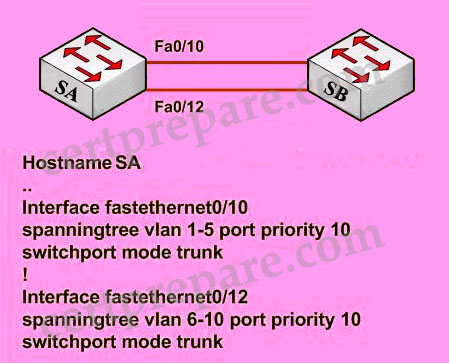VLAN Questions 4
Here you will find answers to VLAN Questions – Part 4
Question 1
Which three statements apply to access control of both bridged and routed traffic for VLANs? (Choose three)
A. Router ACLs can be applied to the input and output directions of a VLAN interface
B. Bridged ACLs can be applied to the input and output directions of a VLAN interface
C. Only router ACLs can be applied to a VLAN interface
D. VLAN maps can be applied to a VLAN interface
E. VLAN maps and router ACLs can be used in combination
Answer: A C E
Explanation
Bridged ACL (or VLAN Access-list, or VLAN map) is used to filter traffic that is flowing within a VLAN. It can only be applied to a VLAN, not interface -> C is correct.
An Interface VLAN (or Switch Virtual Interface – SVI) is very similar to a physical interface on a router, although it is a virtual interface only. We can apply Router ACL to the inbound and outbound direction of a VLAN interface -> A is correct.
To apply access control to both bridged and routed traffic, you can use VACLs alone or a combination of VACLs and ACLs. You can define ACLs on the VLAN interfaces to apply access control to both the ingress and egress routed traffic. You can define a VACL to apply access control to the bridged traffic. -> E is correct.
Note: In CCNA we learned about Access list, in fact it is Router Access list.
Question 2
When you create a network implementation for a VLAN solution, what is one procedure that you should include in your plan?
A. Perform an incremental implementation of components.
B. Implement the entire solution and then test end-to-end to make sure that it is performing as designed.
C. Implement trunking of all VLANs to ensure that traffic is crossing the network as needed before performing any pruning of VLANs.
D. Test the solution on the production network in off hours.
Answer: A
Explanation
Implementation Plan
+ Some examples of organizational objectives when developing a VLAN implementation plan could include: improving customer support, increasing competitiveness, and reducing costs
+ When creating a VLAN implementation plan, it is critical to have a summary implementation plan that lays out the implementation overview.
+ Incremental implementation of components is the recommended approach when defining a VLAN implementation plan.
Question 3
Two switches SA and SB are connected as shown below. Given the below partial configuration, which two statements are true about VLAN traffic? (Choose two)

A – VLANs 1-5 will be blocked if fa0/10 goes down.
B – VLANs 6-10 have a port priority of 128 on fa0/10.
C – VLANs 6-10 will use fa0/10 as a backup only.
D – VLANs 1-10 are configured to load share between fa0/10 and fa0/12.
Answer: C D
Explanation:
Let’s assume that SA is the root bridge for all VLANs, it will make the explanation a bit clearer…
First we should understand what will happen if nothing is configured (use default values). Because we assumed that SA is the root bridge so all of its ports will forward. SB will need to block one of its ports to avoid a bridging loop between the two switches. But how does SB select its blocked port? Well, the answer is based on the BPDUs it receives from SA. A BPDU is superior than another if it has:
1. A lower Root Bridge ID
2. A lower path cost to the Root
3. A lower Sending Bridge ID
4. A lower Sending Port ID
These four parameters are examined in order. In this specific case, all the BPDUs sent by SA have the same Root Bridge ID, the same path cost to the Root and the same Sending Bridge ID. The only parameter left to select the best one is the Sending Port ID (Port ID = port priority + port index). If using default values, the default port priority’s value is 32 or 128 (128 is much more popular today but 32 is also a default port priority’s value), so SB will compare port index values, which are unique to each port on the switch, and because Fa0/12 is inferior to Fa0/10, SB will select the port connected with Fa0/10 (of SA) as its root port and block the other port.

To change the default decision of selecting root port, we can change the port priority of each interface. The above picture is true for VLAN 1-5 because port Fa0/10 has a lower port-priority so the peer port will be chosen as the root port. For VLAN 6-10, port Fa0/12 has higher priority ID (lower port priority value) so SB will block its upper port.
For answer A – “VLANs 1-5 will be blocked if fa0/10 goes down” – is not correct because if Fa0/10 goes down, SB will unblock its lower port therefore VLANs 1-5 will still operate.
For answer B – “VLANs 6-10 have a port priority of 128 on fa0/10” – is not always correct because VLAN 6-10 can have a different port priority (of 32) according to the Cisco’s link below.
Answer C is correct because VLAN 6-10 uses Fa0/12 link as it main path. Fa0/10 is the backup path and is only opened when port Fa0/12 fails.
Answer D is correct because this configuration provide load-balance traffic based on VLAN basis. VLANs 1-5 use Fa0/10 and VLANs 6-10 use Fa0/12 as their main paths.
Note: We can not assure the answer B is always correct so we should choose C and D if the question asks us to give only 2 choices).
Reference (and good resource, too):
http://www.cisco.com/en/US/tech/tk389/tk621/technologies_tech_note09186a00800ae96a.shtml


